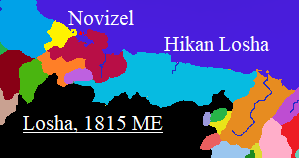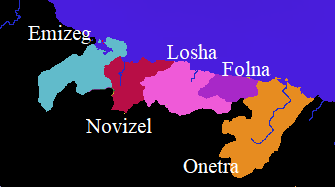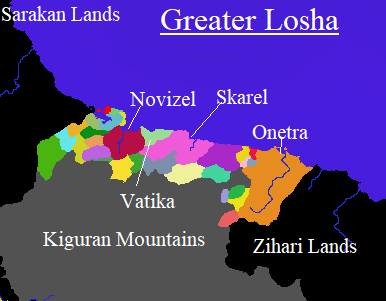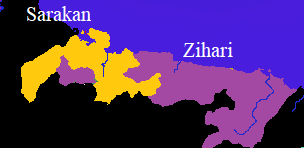Early History (400 - 1200 ME)
Little is known about Loshan history prior to 400 ME, as the region was mostly occupied by small nomadic tribes and villages with loose borders and little social hierarchy. Things began to change in the mid to late 400s, with the arrival of wealthy East Garadek merchants that were looking for more resources and trading partners, and who began to play kingmaker among the local families and villages. These merchants also brought the
Divine Contact with them in the late 400s, introducing a new religious influence to go with this political turmoil. Many of these newly minted monarchs and elites associated themselves with specific Lunar gods as they conquered and accumulated, and Lunar cult overtook local religious traditions. Local kingdom-building took much of the 500s and early 600s, but by the mid 600s ME these new states and cults had become entrenched enough in local life to really start fighting one another for dominance.
The squabbling of local kingdoms ultimately became the squabbling of Lunar cult factions, which consolidated during the mid 600s. These Lunar wars never really stopped from 660 to 820, though some provinces had moments of peace within that time. Generally speaking, the prisms near the Kiguran mountains aligned with
Jade and
Hiku;
Lily of Red built a stronghold for herself in the Northwest;
Orchid of Blue and
Wimbo cults took over much of the central coastline; and
Ishkibal built two very different cults in the Southern plains and in the far Northern swamps (modern day Anashtra). And in the far South, local traditional religious leaders overthrew their own divided Cults of Lily, Theia, and Hiku with the help of
Emesh - forming a loosely Emesh-affiliated religion in modern day Onetra.
By 820, the more aggressive pseudo-
Ishkibites were utterly wiped from the world, the Hiku-Jade coalition had seized the coastline as the dominant cult, and the Lily and Ishkibal cults in the North had moderated their ideology. The cultists made peace between each other (despite the rage of their Gods), and Losha stabilized for a time. This peace shuttered at times - large nomadic invasions from the far North struck the region from 820 onwards, and in the 920s a resurgent Lily cult tried form itself into an organized religion and political force and reignited the old Lunar wars. The late 1000s and 1100s were again more peaceful, but the Lunar wars just kept restarting - in the 1200s, Hiku and Jade cults turned on one another. When the third round of Lunar fighting ended, Hiku cult was dominant along the coast while Jade cult was dominant towards the mountains, and other Lunar cults in the North and Center operated underneath these primary prism cults. Emesh-aligned religious traditionalists held strong in Onetra all through this. The Hiku cult ultimately ended up retreating to the central riverlands of Lesser Losha, where they met up with cultists of the other major West Garadek Hiku cult (known as the Quenta) and started building a grand kingdom and dogma - hijacking some of the infrastructure Lily made to similar ends, but in broader strokes and with more room for other Gods.
Rise of Zihari (1200 - 1580)
While the Hiku and Jade cults built two different models for how the Lunar Pantheon could be rule and be worshipped, a new competitor was rising in the Southeast: The Holy League of
Zihari. Zihari was not unfamiliar in Losha as an ideology at this point, as wandering hermits had brought earlier versions of the faith in the late 700s ME and early 800s. In 815, a nomadic empire known as the Mizram brought early Zihari to the Western plains. That Zihari was less apocalyptic, less formalized, more communal, and less institutionalized: it was more a statement of the value of individual lives in a broken world and a rejection of the Lunar Pantheon than commitment to a formalized religious organization or rigid worldview. But the Holy League, formed in 1100 ME, changed all that - it created an international pool of knowledge and resources for those willing to submit to the structure and dogma of their group, and it promoted a kind of radical rejection of traditional ritual and community structures that prior forms of Zihari hadn't. It was the Zihari of a modern age, a Zihari of blades and desperate emotion and commercial contracts.
In the 1236, Onetra (with their traditional religion and Emesh cult) joined the Holy League under pressure from the neighboring kingdom of Okozel. In 1250, a grand fleet was sent to accompany a group of expeditions Westward, to carry Zihari to the West and discover any possible
Dragon Forges in the Western mountains. This fleet was unable to pressure the Hiku or Jade cultists or their kingdoms into joining, but were able to reach out and connect with the existing nomadic Zihari, which became known as the "Ember League" (this fleet never found any of the "Lost Forges", but did end up assisting an invasion of
Loanua to make up its costs).
The 1250 fleet was more exploratory than conquest-driven, but it opened up routes and structures for a flood of Zihari missionaries and adventurers to carve through the West. Many were still looking for those Dragon Forges as a primary objective, but their expeditions wore aware at local traditions and strengthened developing Zihari networks. By 1330, the Lunar cult kingdoms of Losha were on the defensive rather than the offensive. They fought off adventurers, suppressed missionaries, and defended themselves from neighboring states, but the Lunar cults struggled to sell their own ideology outside of Losha. The kingdoms fell to internal squabbling and the Lunar Cults had to fight for survival across the 1400s and 1500s. The Jade cultists retreated to the mountains for safety and isolation, where they remain to this day. The Hiku-led Lunar cult clung to power, though, and bided its time for the fall of Zihari dominance in the West.
The First Clashes (1580 - 1923)
In the late 1500s, Western Garadel became more connected to the broader trade networks of the world, and control of the path to the West became more profitable. Losha became more important to foreign interests, and Zihari also became more divided between the Ember League and Holy League. In 1680, the Ember League collapsed and was replaced by the emerging religion of Sarakism, driving a wedge between Western and Eastern Zihari and freeing Losha from Zihari pressures.
Already, during the early 1600s, several Loshan states were reaching out to the Garadek branch of the Pratasam (a Samvaran religion very close to Lily of Red cult belief) for an alternative power structure to the Holy League. When the Ember League fell, it was a free for all for the Loshan kingdoms to gravitate to whichever rising faction aligned best with their religion or offered the best trade deal. Emizeg and Vatika, in the far North and the center of Greater Losha, embraced Pratasam fully and opened up selkie ports and druidic temples. In between those regions was Novizel, which joined the rising Sarakan faction. The Loshan heartlands of the Hiku Cult fell between Pratasa and Sarakan factions, and the Southlands of Onetra drew together in Zihar solidarity (paving the way for their unification).
The Pratasa's strict social hierarchies, aggressive evangelism, and foreign culture ruffled many feathers as their influence in the region expanded. In 1780, the Sarakan temple rallied its kingdoms to help the Sarakan kingdom of Novizel defeat the Pratasa in the North, and the long-standing tensions erupted into a full-on trade war. Zihari and Saraka joined forces to remove the Pratasa from the region, and in 1795 the Pratasa were largely cut off from their client kingdoms - believers remained, but their material support withered.
In 1801, the Kingdoms of Lesser Losha united under Willen Byellek, a human paladin of Hiku who was able to unite the Lunar Cults once more and play Sarakan and Pratasa elites against the Zihari. Willen forged a grand kingdom of Losha, which flirted with Sarakism commercially while internally rejecting all organized faith but that of the late Hiku Cults.

But the rising kingdom of Losha would not remain Sarakan-aligned forever. In 1849, Losha invaded the kingdoms South of Novizel, and began openly dissolving Sarakan religious communities to better impose their own increasingly rigid faith. In 1883, Losha jumped straight into an invasion of Novizel, a brazen challenge to the Sarakan temple to dispute their autonomy and regional authority. The newly minted kingdom of Anashtra, militaristic and bearing its own unpleasant histories with Lunar Cult (specifically Ishkibism), attacked before the Sarakan temple could even coordinate against Losha. Novizel's Eastern core was saved from Loshan occupation, and a series of wars between Anashtra and Losha began that would carry on until 1923.
A Century of (1923 -
In 1922, Anashtra was on the verge of ultimate victory. Twenty years prior, it had defeated Losha's armies but failed to properly dismantle the kingdom as it had hoped; when Anashtra returned to war in 1919, it hoped to fully occupy and annex Losha once and for all. Such a move would surely upset the Holy League and strain relations with the far East, but Anashtra was ready to risk it. Unfortunately for them, said Holy League stole their victory: while Loshan forces flung themselves against the Anashtran advances, a large fleet of Holy League warriors, veterans of the wars against the Pratasa in the East, landed in Losha and captured the royal family. They declared all of Losha to be property of the Holy League's chosen aristocrats. Anashtra, not having mobilized enough to face an unknown quantity of Ziharan invaders, accepted their stolen conquest in exchange for them releasing the West as Sarakan buffer states.
The occupied Zihari kingdom hated their new masters, and it quickly collapsed under foreign rule. The Holy League doubled down in 1938 and sent a new fleet to conquer it as direct temple territory. Not only did the region need to be locked down to contain Pratasa influence in the West, but it would serve as a clear message to the Sarakan temple to stay in their corner of Garadel. Unfortunately, the invasion was underfunded and largely botched and only dragged Zihari and Sarakan powers into conflict. The Holy League forces skirmished with Anashtran forces in the West and the war against the Lunar cults became a war against Anashtra in 1941. That war escalated wildly out of control as the Holy League and Sarakan temple sent more and more reinforcements, but ended inconclusively in 1946, after the Loshan kingdoms signed their own treaty and the thin pretense for the war vanished.
Peace reigned from 1946 to 1960, but the Anashtrans and Holy League veterans stationed in Losha spent a fair amount of that time fuming. In 1960, the Sarakan temple was struck by an internal crisis and the Zihari Guardian Lord jumped to restart the Loshan wars. This second war was taken less seriously by both sides than the first, and it petered out completely in 1976. Tension between the two temples flared up again in 1990, and both parties ended up playing out their commercial rivalries on Loshan soil. Conflicts were mostly skirmishes and small engagements for two decades, though a rogue Zihari expedition from Zonostra suddenly escalated this in 2010. The Zonostrans failed to keep up with what they started, and the Sarakans won a number of battles from 2010 to 2015. Much of the Sarakan side of the war was also taken over entirely by Anashtra, which began vassalizing the Sarakan kingdoms.
In 2016, both sides tried to de-escalate through peace talks, but this has been process has been patchy. While the war is now on-and-off, it has continued escalating while active as both religious factions have sent considerable naval forces (with little land support) to try and cow the other.







Comments